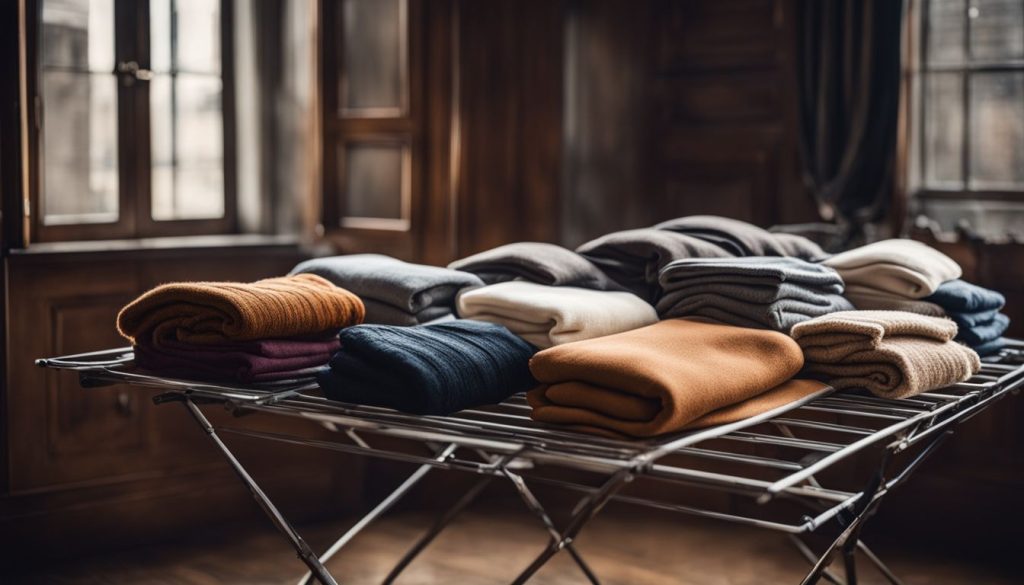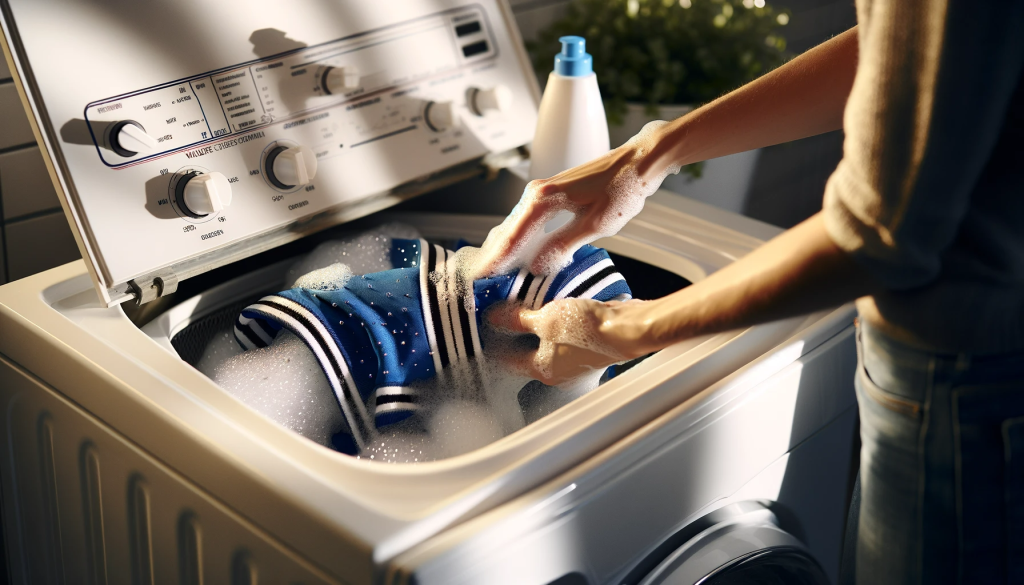perfect condition, knowing which materials to avoid putting in the dryer is crucial. From delicate silks to intricately adorned garments, protecting your wardrobe starts with understanding its needs. For those looking to expand their collection with pieces designed for longevity, explore the quality options available at inktasticmerch.com.
Have you ever taken a beloved shirt out of the dryer only to discover it had shrunk or become distorted? Many of us have faced this common issue, as some fabrics and garments don’t fare well in high heat. This guide provides essential insights into which clothes should steer clear of the dryer and how to keep them looking their best.
Stay tuned; your wardrobe will be grateful!
Key Takeaways
- Delicate fabrics like spandex, silk, lace, and sheer net are easily damaged by heat; it’s wise to lay them flat or hang them to air dry to maintain their shape and avoid shrinkage.
- Garments with embellishments such as sequins or beads can suffer damage or loss in the dryer; it’s advisable to let them dry naturally to protect the adhesives and decorations from melting or breaking.
- Consider using a mesh laundry bag for small or fragile items in the dryer, switch to dryer balls for a more natural softening effect, and remember to clean the lint trap after each cycle for optimal safety and performance.
- While robust fabrics like denim and cotton usually withstand the dryer, always check the care labels—some pieces might need low heat or specific instructions to prevent damage.
- For optimal fabric care: Hang drying is best for most clothes, especially delicates; avoid overloading the dryer; use lower heat when needed; and always read clothing labels before drying.
Materials to Avoid Putting in the Dryer

While your dryer might seem like a magical time-saver, it can spell disaster for certain textiles. To keep your clothes in excellent condition, let’s explore the materials that should steer clear of the heat and tumble of your drying machine.
Spandex (bras, gym clothes, swimwear)
Spandex, frequently found in bras, gym wear, and swimsuits, reacts differently to heat compared to other fabrics. High temperatures can strip this stretchy material of its elasticity.
To preserve the shape and fit of your spandex garments, air drying is ideal. Using the dryer not only endangers the fibers but also risks shrinkage or warping.
Proper care is crucial for those who wear spandex gear for sports or swimming to ensure longevity and functionality. Instead of using the dryer, lay these items flat or hang them after washing them in cool water with a gentle detergent formulated for delicate fabrics.
Avoid drying them in direct sunlight as it can lead to faded colors and weakened fibers over time. Adhering to these laundry tips will help your activewear maintain its snug fit and comfort through numerous workouts and swims.
Delicate Fabrics (silk, lace, sheer net)
Much like spandex, delicate fabrics such as silk, lace, and sheer net require special care. These textiles are particularly vulnerable to heat, making the dryer a risky choice.
Silk can lose its delicate sheen and texture at high temperatures, while lace may shrink or tear due to its intricate patterns. Sheer net is likewise prone to snags and can become distorted if treated carelessly.
For preserving the beauty and longevity of these sophisticated materials, air drying is the safest option.
Lay silk items flat on a towel to dry—this helps prevent stretching. Lace should be hung or laid flat in a shaded area to protect its delicate colors from fading under direct sunlight.
For delicate net fabrics, ensure they’re smoothed out meticulously after wash and placed in a well-ventilated area for natural drying. Checking garment care labels is vital as they offer essential care instructions for each fabric type, ensuring your precious garments retain their elegance and comfort over time.
Leather, Faux Leather, and Suede
Leather, faux leather, and suede require specific attention in laundry routines due to their sensitivity. Exposure to dryer heat can lead to warping or shrinking.
Lay them flat or hang them on padded hangers for air drying to protect their form and surface. Avoid sunlight, which can fade colors and damage authentic leather.
Similarly, wool requires gentle care—it’s next up on our list of materials best left out of the dryer. The fibers tend to felt together under heat, causing irreversible shrinkage and distortion.
Preserve your warm woolen items by choosing air drying whenever possible.
Wool
Wool sweaters and apparel require special treatment since dryer heat can cause shrinkage and felting. Gently press out excess water, but never wring them to prevent altering their shape.
Air dry them flat on a towel, reshaping as necessary to retain their original fit and look.
This method helps protect the structure and natural fibers of wool. Keeping wool away from direct sunlight during drying helps avert color fading. Always adhere to the specific laundering instructions to take proper care of wool garments, extending their lifespan.
Clothes With Embellishments (sequins, beads)
Garments adorned with sequins or beads infuse glamor into your closet but can suffer damage in the dryer. The heat and tumbling motions may cause these ornate details to detach or harm the fabric.
Handle these pieces with caution by air drying or selecting a gentle cycle if a machine is necessary.
To maintain the allure of embellished clothing, lay them flat on a towel, steering clear of direct sunlight. This practice helps safeguard adornments and prevents any glue securing sequins or beads from melting.
By following this approach, you’ll ensure your wardrobe keeps its delightful appeal and continues to captivate onlookers.
Safe Materials for the Dryer

Understanding which fabrics can confidently endure the tumble and heat of a dryer can simplify laundry tasks. Let’s explore which everyday items can safely join the dryer cycle.
Denim
Denim is robust enough to handle the heat and motions of a dryer, maintaining its shape. Jeans, denim jackets, and other pieces typically emerge with fewer wrinkles and a cozy fit.
Remember to turn denim items inside out before tossing them in, preserving their color and curbing any fading.
A medium heat setting keeps your denim looking crisp and fresh.
temperature control helps avoid unwanted shrinkage or damage over time. Regularly clearing the lint trap boosts your clothes’ drying efficiency and shields your cherished textiles from excess lint or debris accumulation.
This easy fabric care routine keeps your favorite jeans ready to wear without demanding extensive upkeep.
Cotton
Cotton clothing is generally dryer-friendly, making it a convenient choice for quick laundry cycles. This fabric can endure the heat and spinning of most machines, leaving shirts, jeans, and sheets soft and pleasant.
But be cautious with the temperature settings; excessive heat can lead to cotton shrinking. For the best care, choose a moderate or low setting.
To keep your cotton apparel in excellent condition, be sure to clear the lint trap before each drying session. Lint buildup from cotton can hinder efficient drying and pose a fire risk if neglected.
Shifting our focus from natural fibers like cotton, let’s delve into synthetic options such as polyester blends, which demand their own unique garment care methods.
Polyester Blends
Polyester blends are often reliable picks for the dryer. These fabrics merge polyester with other materials, crafting a sturdy combination that withstands high heat and spinning well.
Unlike pure polyester, which might require low-heat settings, these blends are typically resistant to shrinking and preserve their form after drying, making them ideal for busy homes seeking hassle-free garment maintenance.
However, not all polyester blends are created equal; always consult the laundry label before tossing items into the dryer, as some might necessitate gentle cycles or lower heat to prevent damage.
Turning our attention to bed sheets and pillows, these items often belong on the “safe” list but always check for specific fabric content and care symbols for guidance.
Bed Sheets and Pillows
Bed sheets and pillows generally endure the dryer’s warmth and spinning more effectively than fragile items. Cotton sheets, in particular, come out soft and cozy when dried correctly.
Always check the label for any specific fabric care instructions before including them in your laundry. Opt for a medium heat setting to avoid shrinkage or damage to the elastic on fitted sheets.
Drying pillows helps fluff them post-wash, but caution is advised with foam inserts as they might suffer heat damage. For down or feather pillows, consider adding a few dryer balls to maintain their shape without clumping.
Ensure they are thoroughly dried before use; lingering dampness can cause mildew, which is undesirable for both preservation and hygiene.
Best Practices for Keeping Your Fabrics Safe While Drying

Adopting effective practices while drying makes a notable difference in preserving your clothing’s quality; stay tuned to discover how minor tweaks in your routine can protect your cherished apparel.
Use a Mesh Laundry Bag
Safeguard your delicate apparel in the dryer by employing a mesh laundry bag. This straightforward
Incorporating mesh laundry bags into your routine protects delicate fabrics from getting snagged or tangled with other items, ensuring proper care for materials like lace and silk.
Even small pieces, such as socks, won’t go missing when secured inside these convenient bags.
Choose separate mesh bags for different colors and fabric types to follow garment care best practices. This approach minimizes color bleeding and fabric friction, allowing you to dry clothes without risking damage to your favorite outfits.
This method not only prolongs the life of your clothes but also helps maintain their shape and texture during drying.
Use Dryer Balls Instead of Dryer Sheets
After protecting your delicates with mesh laundry bags, enhance your fabric care routine by choosing dryer balls over traditional dryer sheets. These balls are an environmentally friendly alternative that boosts air circulation in the dryer drum.
This enables clothes to dry faster and more evenly, conserving energy and lowering electric bills.
Unlike dryer sheets, which can leave a chemical residue, dryer balls are a safer choice for individuals with sensitive skin or allergies. Wool or rubber dryer balls naturally soften clothes without synthetic fragrances or irritants, preserving fabric softness.
These durable spheres last far longer than disposable sheets, offering a cost-effective and sustainable solution for laundry care.
Regularly Clean Your Dryer’s Lint Trap
Replacing dryer sheets with dryer balls can improve airflow, and speaking of airflow, maintaining a clean lint trap in your dryer is essential. A blocked lint filter can significantly hinder efficiency, forcing the dryer to expend more energy and accelerating wear on garments and the appliance.
Make it a routine to clear out lint after each load; this small act is key to fabric care and extends the life of your cherished clothes.
Cleaning the lint trap is not only about efficiency but also safety. Excess lint is a fire hazard, as dryers generate intense heat, making it possible for fluff to catch fire.
Integrating regular cleaning into your laundry process ensures that you’re safeguarding your textiles and adhering to safety measures at home. By paying attention to this detail, you preserve your garments and ensure each drying cycle is protective.
Additional Tips for Protecting Your Fabrics
For those committed to maintaining their wardrobe in perfect condition, we have extra tips on fabric protection. Discover savvy strategies beyond dryer settings to keep your clothes fresh and stylish for years.
Hang Dry Delicate Items or Use a Clothing Rack
Hang drying preserves your delicate items from the harshness of a dryer. Fabrics like silk, lace, and sheer net require gentle care to maintain their shape and texture.
Using a clothing rack allows air to circulate freely, reducing the risk of shrinkage and damage caused by heat. For items with intricate details like sequins or beads, laying them flat on a towel or using a hanger helps retain their design.
This approach not only protects fabrics but also conserves energy and prolongs the life of your wardrobe pieces.
Clothing racks offer versatile garment care solutions, providing safe options for air-drying a variety of clothes.
Enhancing the space in your laundry room can be as simple as taking things indoors or into the fresh air, especially for those clothes that need special care.
When dealing with wool sweaters or spandex exercise wear, choosing alternatives to the dryer can help maintain the fabrics’ elasticity and prevent them from becoming distorted.
Using effective laundry methods like air drying allows your favorite clothes to remain pristine through numerous wears while adhering to optimal laundering practices.
Avoid Overloading the Dryer
Filling the dryer to capacity might seem time-efficient, but it can actually be counterproductive. Clothes need room to move freely for consistent heat dispersion and complete drying.
Overcrowding can lead to damp patches on fabrics and might even damage the dryer’s components due to excess strain on its mechanisms. Keeping laundry loads light ensures all items receive sufficient airflow, maximizing fabric care.
Resist the urge to add just one more towel or pair of jeans, as this compromises proper drying and amplifies wrinkling and fabric wear. Consistently follow good laundry habits by providing clothing with the necessary space in the machine—essential for preserving garments and adhering to top garment care principles.
Use a Lower Heat Setting for Delicate Items
Lower the heat for delicate items to protect them. Fabrics such as silk, lace, and sheer materials cannot withstand high temperatures and may be damaged as a result. By selecting a lower heat option on your dryer, you preserve the texture and shape of these fragile materials.
It’s a small but crucial fabric care step that makes a significant difference for items requiring gentle handling.
Make it standard practice to adjust the temperature based on the load’s contents. Apparel adorned with sequins or beads also benefits from cooler drying conditions, preventing the loss or dulling of embellishments.
This method is vital for garment maintenance, prolonging the life and appearance of your cherished clothing pieces. Reading labels helps too—always adhere to garment care instructions for optimal results in safeguarding your wardrobe essentials.
Check Clothing Labels for Care Instructions
Prior to tossing clothing into the dryer, always read the care labels. These small tags offer vital guidance on protecting your garments and ensuring they look their best.
Labels provide specific fabric care instructions, saving you from shrinking, distorting, or completely ruining a beloved clothing item. They inform you whether air drying is preferable or if a low-heat tumble is permissible.
Pay close attention to the symbols and follow the garment care recommendations accurately. If it indicates “lay flat to dry,” make sure to allocate space for the item to rest until it is ready to wear again. By strictly adhering to these care guidelines, you keep your wardrobe in perfect condition and extend its lifespan.
Observing washing label instructions can distinguish between prolonging the life of your clothing and having to replace them prematurely due to poor handling.
Conclusion
Caring for your clothes involves understanding which items can withstand heat and which require gentler handling. Knowing which garments should stay out of the dryer prevents them from shrinking, warping, or being entirely ruined.
Embrace these laundry success tips and remember to treat your garments with respect. Rely on air-drying when necessary, and observe your favorite pieces lasting longer while maintaining their appearance.
After all, smart drying is as crucial as intelligent washing!
FAQs
1. Can I put wool sweaters in the dryer?
No, you should avoid placing wool sweaters in the dryer as they may shrink or lose their shape.
2. Is it safe to dry clothes with sequins or beads?
Do not dry clothes with sequins or beads in the dryer since they might detach or harm the machine.
3. What happens if I dry my sports gear made of high-tech fabric?
Drying sports gear made of high-tech fabric can compromise its special features and fit.
4. Should I use the dryer for silk dresses and shirts?
Silk dresses and shirts are best kept out of the dryer, as heat can ruin the delicate silk fibers.
5. Can I tumble dry garments with rubber or plastic attachments?
Avoid tumble drying garments with rubber or plastic elements since these materials may melt or distort.
For more insightful tips on caring for your wardrobe and other lifestyle advice, be sure to explore our Blog for a wealth of articles designed to enhance your everyday life.




